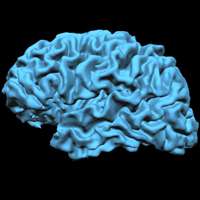MRI brain scan
Exercising goal-directed behavior in the presence of distracting stimuli—for instance, reading a journal-published study amid the crash of surf, the laughter of children, and the crush of beachgoers at a coastal resort on a sunny afternoon—requires the ability to inhibit distracting stimuli. This ability is important in many life settings, including school and work, and is an important pillar of psychological well-being.
Such inhibitory control is impaired in certain circumstances, even in psychologically and neurally typical subjects, including drug addiction and stress-related overeating or other compensatory behaviors. Therefore, identifying the specific neural activity associated with inhibitory control could have valuable clinical applications.
Surprisingly, researchers have conducted few studies of the neurology of inhibitory control. A group of U.S. researchers recently conducted a study with a large number of adults in order to determine how the brain adapts to conditions of distraction during goal-oriented activities, and they have published their results in the Proceedings of the National Academy of Sciences.
Graph theory is a relatively recent methodological advance that allows analysis of brain networks at a previously unobtainable level of complexity. Via graph theory, researchers can identify clusters of network connections in which the strength of each connection varies according to demand—for instance, concentration in a setting of variable distraction levels.
The researchers recruited 101 adults and collected functional magnetic resonance imaging data as the subjects performed a color-word Stroop test. Applying graph theory, the researchers identified clusters of interregional coupling in which connection strength between and within neural networks differed with varying demands for inhibitory control. They also correlated significant network measures with the performance of the subjects in order to determine the behavioral impact of network shifts.
Results
The researchers identified a network of neural nodes that became more interconnected during periods of high demand for inhibitory control. Frontal regions predominated, including the medial dorsal anterior cingulate cortex, the right inferior frontal gyrus and the right anterior insula acting as network hubs.
The researchers found that higher demand for inhibitory control was related to increases in neural node strength in all of the study's brain regions of interest, and that each node had a greater impact on network processing in the presence of distracting stimuli. Meanwhile, the network of connections surrounding each node also became more tightly clustered together, a condition they called "local efficiency."
The findings showed that when greater inhibitory control was needed, the dorsal anterior cingulate cortex becomes more tightly interconnected with other nodes. This suggests that the region has a greater influence on the specific processes occurring within those nodes. And an observed increase in anterior insula node strength suggests that the region orchestrates switches between different functional networks by directing highly connected hubs to bring their module networks online or to down-regulate them based on current needs.
Interestingly, the researchers mapped global network organization, finding that the networks would completely reorganize themselves into highly resilient and efficient configurations to meet the demand for inhibitory control. The authors write, "Although present findings do not have direct clinical implications, they do provide a framework for deeper insight into the particular network dysfunction occurring in populations with known inhibitory difficulties," citing ADHD as an example.
More information: "Flexible brain network reconfiguration supporting inhibitory control." PNAS 2015 ; published ahead of print July 27, 2015, DOI: 10.1073/pnas.1500048112
Journal information: Proceedings of the National Academy of Sciences
© 2015 Medical Xpress





















